

Realtime operating systems (RTOSs) are vital components in many mission-critical platforms – none more so than the Mars Rovers. This Q & A with Mike Deliman, the Wind River developer of the RTOS used in the Rovers, gives some insight into the technical challenges involved in this extreme application.
Q: What is so special about the operating system in the Mars Rovers?
Three aspects make it special - it is flexible, it is predictable, and it is mature.
It is flexible - it can not only be made to run on different kinds of computer hardware, it is designed to be built into things that are not computers, but use them inside. It has been used inside everything from automobiles, MP3 players and TVs, to telecom and network routers, to telerobotic surgeons and remotely operated vehicles. This high degree of flexibility makes it a great candidate for a wide variety of applications, including controlling robotic interplanetary probes.
It is predictable - it does what you expect it to, the way you expect it to, when you expect it to, and it will 'do it again'. It even allows you to create predictable misbehaviour, ways to enforce some degree of predictable behaviour when encountering unpredicted conditions. You can depend on it to do what it is supposed to, and when it cannot, to handle that with some degree of predictable behaviour. Predictable and dependable, in this context, pretty much add up to 'reliable'.
Maturity is key to being predictable. The best way to qualify software is to test and use it, and the wider and more varied the use and test, the better. Our customers have used our software in a large number and wide variety of applications we never could have dreamed of, and that creates a very mature base platform.

Q: What is the most important function in the operating system of a space robot?
This is a very difficult question to answer, and would depend largely on the goals of the mission and functions of the robot. I think you might also get different answers from different scientists and engineers working on the same project.
From my point of view, the most important function of the OS is delivering on the promises of the API (application programming interface) - 'doing what you say you will do'. Being predictable.
Q: Has the mission with the Mars Rovers worked out the way you planned?
From my point of view, my mission plans were to deliver the best help I could, as quickly as possible, to enable the mission to be a success. I would like to think I did well in this effort. It has not been a flawless mission, but at the same time, it has been extremely successful.
I do not think anyone expected the Rovers to last this long, and I think that longevity is something the entire team is proud of.
Q: What is the transfer speed when sending commands to the Rovers?
This is kind of interesting. When they first arrived, we used direct communications, through the high-gain and low-gain onboard antennae. Both of these methods are rather slow by today's standards. We did some experimenting and then decided to use some help - most of the data we get back from the Mars Rovers has been sent from them to satellites in orbit - Mars Odyssey and Mars Global Surveyor - and these methods move data much faster than the direct radio link.
The direct radio links are about 3500 bits per second and 12 000 bits per second, for the low- and high-gain radios respectively. The links to the orbiters are more like 128 000 bits per second.
Q: What do you mean by 'radiation-secured'?
I use the term 'radiation hardened' to describe the CPUs used in the MER Rovers and other space-based projects. It refers to special processes used in the manufacture of the computer components that allow them to run in conditions that would destroy normal computers. Until the recent invention of the Rad750 computer, the Rad6000 (computers inside the Rovers) was the most radiation-hard 32-bit computer available.
Q: Why do the Rovers move at such a slow speed on Mars (40 metres per day)?
The Rovers must conserve energy, because if the batteries go below a certain level we will not be able to recharge them. The systems were designed to be able to operate in higher radiation than on Earth, and to conserve battery energy as much as possible.
Q: What will eventually cause the Rovers to retire?
The most likely thing: the batteries will lose charge, from one cause or another, and the Rovers will run out of electricity. I would put the most likely cause to be dust on the solar panels, and the second most likely cause as thermal stress. Thankfully Mars has been willing to blow the dust off of the panels here and there, as without that I think we might have already lost at least one of the Rovers.
Q: How did you become a space vehicle programmer?
I would say 'I got lucky'. The truth is - when the opportunity knocked, I grabbed it, and have not let go yet. I worked a lot of long and hard hours to be where I was when the opportunity arrived. I was in the right place at the right time - the timing is the lucky part.
Q: Did you or NASA expect that the Rovers would keep going this long?
I do not think anyone expected the Rovers to run this long!
Q: What was your biggest technical challenge when creating the Rover's OS?
Creating the OS for the Rovers is a long story, starting back in 1993 with the Mars Pathfinder program. I was a junior software engineer at the time. I had to develop an understanding of this particular CPU and the board it was on, in a short time and to a point where I could be helpful to the team and our customers and partners. There are several phone-book sized manuals involved, some that talk about how the hardware works and some that talk about how to make software work on the hardware ('ABI'). At that time we were using IBM/AIX as the development host, which was a new flavour of UNIX to me. Within six months I went from being the new junior engineer on the project to taking on the project lead. This was the biggest technical challenge for me - initially coming up to speed at the start of the project.
For more information contact Andrew Palmer, Embedded Industrial Solutions, +27 (0)12 547 6071.
| Email: | [email protected] |
| www: | www.eisol.co.za |
| Articles: | More information and articles about Embedded Industrial Solutions |

© Technews Publishing (Pty) Ltd | All Rights Reserved